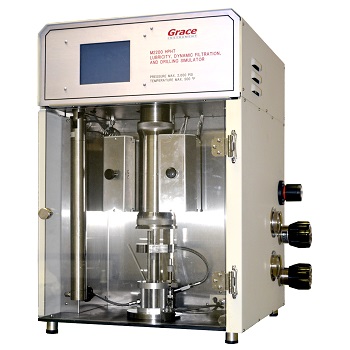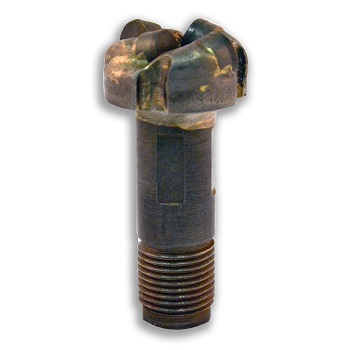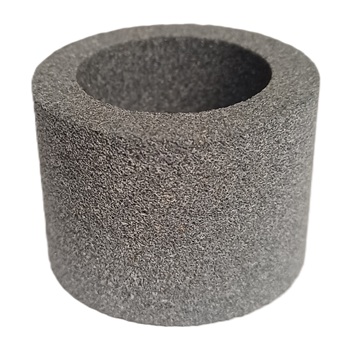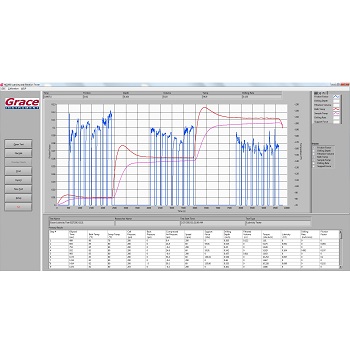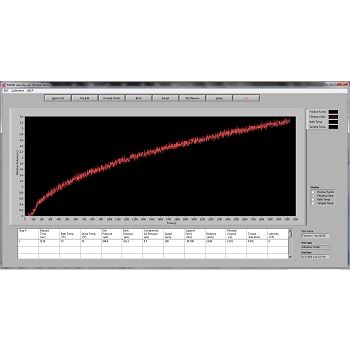Drilling Simulator
M2200 HPHT Lubricity (Tribology), Dynamic Filtration, & Drilling Simulator
- Height: 27.5 in.
- Width: 18 in.
- Depth: 21 in.
- Weight: 250 lbs.
- Max Pressure: 2,000 psi | Max Temp: 500°F (260°C)
- U.S. Patent: 9,194,784
- U.S. Patent: 10,215,001
HPHT Lubricity, Filtration, & Drilling Simulation Multifunction Tester
The benchtop M2200 HPHT Lubricity (Tribology), Dynamic Filtration, and Drilling Simulator offers a computer-controlled test environment
for realistically simulating high-pressure, high-temperature downhole conditions. Its multi-function design reduces the need for multiple
test devices, saving money, training time, research time, and lab space.
The M2200 is fully compliant with API 13.
Real HPHT Dynamic Lubricity Testing
The M2200’s very repetitive COF (coefficient of friction) measurement of plus or minus 0.01 is due to its unique, patented design.
The M2200 is the only HPHT lubricity (tribology) tester available in the USA that is reliable in evaluating
dynamic lubricity performance on different types of drilling fluids, and can do so at high pressure
and high temperature reservoir conditions that are completely user-controlled. The M2200 can evaluate
all oil-based drilling fluids, water-based drilling fluids, and synthetic-based drilling fluids.
Additionally, chemical additives can be blended into the drilling fluid to evaluate the change in the lubricity performance.
Dynamic HPHT Filtration Test (similar to a dynamic filter press)
The M2200 includes a pressurized, temperature-controlled
environment containing a filtrate medium which realistically
simulates a downhole well bore.
When the simulation chamber is filled with drilling fluid under either
static condition or re-circulation condition, a shear bob simulates
the drill string centrally or off-centrally rotating inside of the
filtrate medium to produce a shear inside of the filtrate medium. The
filter cake deposit becomes visible on the interior of the filtrate
medium as the fluid is sheared, and the resulting build-up can be
examined following the completion of the test.
Differential Sticking Test
A differential sticking test can be performed after the filter cake
has been deposited, the load is applied and then the rubbing shoe is
rotated. The torque required to move the rubbing shoe is measured.
Particle Plugging Test
Lost circulation is the uncontrolled flow of whole drilling fluid into a
formation with no return to surface, especially within those
formations that are inherently fractured, cavernous, or have high
permeability. Lost circulation also occurs when improper drilling
operations damage the mud cake as drilling fluid invades and
further damages the formation.
The M2200 includes a specialized filtrate medium with an artificial
fissure that can be used to perform particle plugging tests, which
determine the effectiveness of additives, such as bridging materials, to help prevent lost
circulation in the filtrate medium. The M2200 simulates
an off-centric drill string rotating and damaging the filter cake.
Real HPHT Drilling Simulation System
The M2200 can be also used to simulate drilling operations
and optimize mud systems to reduce overall drilling costs.
The M2200 hardware includes an ultra-realistic well-bore
simulation chamber, which allows the user to test the
penetration rate on actual core samples using a real drill bit.
The core sample options can be different types, such as
sandstone, limestone, ceramic, etc., allowing the user to select
for the matching rock parameters of the reservoir to be drilled.
The penetration rate is measured through linear transducers.
The pressure and temperature of the simulation chamber are
controlled by custom M2200 PC software, which monitors and
records test results in real time. Filtration during the drilling
process is measured and recorded as well.
An optional mud circulation pump is available at reduced temperature and pressure conditions.
The instrument also includes custom software called
M2200 PC, which gives the user the ability to create test
sequences with multiple testing parameters.
We also offer the M2170 HPHT Lubricity (Tribology) Tester and the M2180 HPHT Dynamic Filtration LCM Tester.
| U.S. Patent Numbers: 9,194,784 and 10,215,001 | |||
| Dimensions: 27.5" H x 18" W x 21" D | |||
| Weight: 250 lbs. | |||
| Temperature Range: Amb. to 500 °F (260°C) | |||
| Working Pressure: 2,000 psi | |||
| Max Load (Normal) Force: 600 lb | |||
| Voltage: 220-240V AC at 50-60 Hz | |||
| Frequency: 50-60 Hz | |||
| Power: 1,200 W | |||
| Sample Volume: 350 ml | |||
| Max Filtrate Volume: 45 ml | |||
| Shear Bob Speed: 0 to 600 rpm | |||
| Compliance Standards: Fully Compliant with API 13B | |||
| Operating System Requirements: Windows 9X/2000/XP/Vista/7/8/10/11 | |||
| Lubricity/Differential Sticking Tester |
Dynamic HPHT Filtration Tester |
Particle Plugging Tester |
Real HPHT Drilling Simulator |
| Max Torque: 120 lb./in. (14 N.m) |
Max Differential Pressure: Determined by Core Strength |
Max Differential Pressure: Determined by Core Strength |
Max Differential Pressure: 500+ psi (Or Determined by Core Strength) |
| Coefficient of Friction (COF) Accuracy: ± 0.01 (Particle fluids may experience high errors.) |
-- | -- | Max Torque: 120 lb./in. (14 N.m) |
| -- | -- | -- | Max Penetration Depth: 1 inch |
| -- | -- | -- | True measurement of rate of penetration (ROP). |
- The M2200’s very repetitive COF (coefficient of friction) measurement of ±0.01 is due to its unique, patented design.
- Newly designed cell cap is interchangeable with older cells.
- Heating jacket can be locked at 30° inclined angle for the easy installation and extraction of test cell.
- Programmable temperature controller increases the cell temperature at desired rate.
- The M2200’s unique design allows it to equip a rubber wiper that can intentionally damage/wipe mud cake off the filtration element. This simulates the high angle drilling situation of a drill pipe sitting on the bottom of a well hole.
- The M2200 can simulate both concentric and off-centric location of drilling pipe of the drill hole.
- Apparatus is in accordance with API Recommended Practice 10B-2.
- Fully compliant with API 13B.
- Includes custom M2200 PC software.
Downloads for the M2200 Lubricity Dynamic Filtration Drilling Simulator:
Read more about our instrument's technical applications within these scientific and academic publications:
-
Nafta-Gaz, 2023, R. 79 No. 3, 157-170 2023
Drilling mud based on synthetic polymers with the addition of nanomaterials adapted to borehole conditions
Filtration of cores with a porosity of 20 μm were performed with a Grace M2200 Lubricity Tester.
https://yadda.icm.edu.pl/yadda/element/bwmeta1.element.baztech-299fde88-2236-424e-b9cc-9a9834b57a78?q=bwmeta1.element.baztech-dabc15aa-0811-42ff-85d7-002a9bbc6808;1&qt=CHILDREN-STATELESS
-
Nafta-Gaz, 2023, R. 79 No. 3, 171-183 2023
Influence of washing liquids on the quality of cementing pipes after using drilling muds with different hydration inhibition mechanisms
A Grace M2200 Lubricity Tester was used to produce mud sludge under hole-like conditions.
https://yadda.icm.edu.pl/yadda/element/bwmeta1.element.baztech-f2f65e6e-845a-48a3-968c-a7faaed177b4
-
Nafta-Gaz 2022, nr 5, s. 375-385 2022
Polymers, synthetic, for regulating the filtration of drilling muds under elevated temperature conditions
Dynamic filtration results from synthetic polymers used to regulate drilling fluids were measured using a Grace M2200 Lubricity Tester.
https://www.inig.pl/magazyn/nafta-gaz/Nafta-Gaz_2022-05-05.pdf
-
AADE 20 FTCE 005 Hoxha 2020
Enhanced Dynamic Lubricity Testing and Drilling Simulation Under Downhole Conditions to Characterize and Differentiate Drilling ROP Enhancers and Lubricants
Click here to download the PDF.
-
Nafta-Gaz 2019, nr 5, s. 275-282 2019
Possibilities of improving the lubricity properties of drilling muds used in industrial conditions
Dynamic fluid invasion experiments were conducted using the M2200 drilling simulator. Effectiveness tests of four lubricants in drilling fluids were tested using a Grace 2200 Lubricity Tester.
https://www.inig.pl/magazyn/nafta-gaz/Nafta-Gaz_2019-05_5.pdf
-
Journal of Petroleum Exploration and Production Technology, March 2019, Volume 9, Issue 1, 281-296 2019
Smart Lost Circulation Materials for Productive Zones
Dynamic fluid invasion experiments were conducted using the M2200 drilling simulator.
https://link.springer.com/article/10.1007%2Fs13202-018-0458-z
-
Journal of Energy Resources Technology, January 2019, Volume 141, Issue 7 2019
A Holistic Approach to Characterize Mud Loss Using Dynamic Mud Filtration Data
The dynamic mud filtration experiments were performed using the M2200 drilling simulator.
http://energyresources.asmedigitalcollection.asme.org/article.aspx?articleid=2719407
-
ARMA-2018-544 2018
Pore-Scale Mud Invasion in Different Rock Samples and Wellbore Conditions: Implications for Lithology Dependent Wellbore Strengthening
M2200 drilling simulator was used to perform the dynamic-radial mud invasion experiments.
https://onepetro.org/conference-paper/ARMA-2018-544
-
SPE-189596-MS 2018
A New Approach to Characterize Dynamic Drilling Fluids Invasion Profiles in Application to Near-Wellbore Strengthening Effect
Dynamic fluid invasion experiments were conducted using the M2200 drilling simulator.
https://onepetro.org/conference-paper/SPE-189596-MS
-
SPE-189509-MS 2018
Integrated Image Processing and Computational Techniques to Characterize Formation Damage
Dynamic fluid invasion experiments were conducted using the M2200 drilling simulator. The advantage of using this approach is that it simulates drill pipe rotation with drilling mud inside the inner diameter of a core.
https://onepetro.org/conference-paper/SPE-189509-MS
-
SPE-189471 2018
Investigating Impact of Rock Type and Lithology on Mud Invasion and Formation Damage
Characterizing water based mud’s invasion and damage to different rock cores representing various lithologies, under simulated dynamic wellbore condition. M2200 has been used to simulate dynamic wellbore condition as a drilling simulator, capable of rotating a shaft that is centered between the inner diameter of the damaged porous media. Using this approach, the formation damage profile of WBM on different lithologies was investigated.
https://onepetro.org/conference-paper/SPE-189471-MS
-
Journal of Natural Gas Science and Engineering, Volume 51, March 2018, 104-115 2018
Experimental and statistical investigation of drilling fluids loss in porous media-part1
Dynamic fluid invasion experiments were conducted using the M2200 drilling simulator.
https://www.sciencedirect.com/science/article/abs/pii/S1875510017304948
-
Journal of Petroleum Science and Engineering, December 2018, Volume 171, 1326-1337 2018
Lost circulation and filter cake evolution: Impact of dynamic wellbore conditions and wellbore strengthening implications
Dynamic fluid invasion experiments were conducted using the M2200 drilling simulator.
https://www.sciencedirect.com/science/article/abs/pii/S0920410518307290
-
OMAE2018-78722 2018
Qualification of Multiple Factors and Interaction Effects on Drilling Fluid Invasion
The dynamic drilling fluid invasion experiments were carried out on the M2200 drilling simulator.
https://doi.org/10.1115/omae2018-78328
-
AADE-17-NTCE-094 2017
How does Rock Type and Lithology Affect Drilling Fluid’s Filtration and Plastering?
Highlight and justify the importance of lithology and rock type, on dynamic mud filtration and plastering. M2200 has been used to characterize dynamic drilling fluid filtration, for different lithologies, at specified experimental conditions.
Click here to download the PDF.
-
AADE-17-NTCE-100 2017
Evaluation of Measurement Techniques for Fluid Lubricity in the Laboratory
Perform a comprehensive study on measurement techniques to evaluate lubricants and the lubricity of drilling fluids. M2200 has been used to perform dynamic lubricity test under varied experimental conditions.
Click here to download the PDF.
-
Composition and Properties of Drilling and Completion Fluids (Seventh Edition), 55-91 2017
Chapter 3 – Evaluating Drilling Fluid Performance
Figure 3.15 M2200 HPHT lubricity, dynamic filtration, and drilling simulator
https://www.sciencedirect.com/science/article/pii/B9780128047514000031
-
International Scientific and Technical Conference 2017
Examination of Drilling Muds Lubricity on Contact with Borehole Wall under HPHT Conditions
The studies were conducted based on the measurement of the coefficient of friction using a Grace M2200 HPHT drilling simulator. The coefficient of friction was determined on steel-steel contact and steel-sandstone contact.
http://194.44.112.14/bitstream/123456789/5964/1/6564p.pdf
-
University of Leoben Master Thesis 2017
Experimental Design to Investigate the Casing Smearing Effect
Lubricity, Filtration, Drilling Simulator – M2200: This apparatus features a temperature and pressure controlled work environment to simulate downhole conditions. The filter medium is available in different porosities and permeabilities. A shear bob can simulate the rotation of the drill string concentric or off-center. This produces a certain shear rate on the filter cake. In an optional version, there is even a mud circulation system applied but only for lower pressures and temperatures. The main advantage of this apparatus is that it can rotate a shear bob off-center, which is exactly what happens during CwD. Nevertheless, it is important to find out if the rotation is simply off-center or if it performs a similar motion as during CwD. This would mean regular contact with the filter medium during rotation. If so, this would be the only apparatus which could simulate CwD conditions realistically so far.
https://pure.unileoben.ac.at/portal/files/1862343/AC13686645n01vt.pdf
-
ARMA 15-82 2015
American Rock Mechanics Association
An Integrated Analytical Workflow for Analyzing Wellbore Stress, Stability and Strengthening
Present an integrated and analytical workflow, such as performing an integrated mud loss volume prediction based on different mechanism. M2200 has been used to do filtration test and generate mud cake for property test.
https://www.onepetro.org/conference-paper/ARMA-2015-082
-
AADE-24-FTCE-026
Improved Laboratory Methods for Understanding Lubricity, Torque and Drag in Non-Aqueous Drilling Fluids

